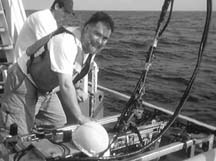
| Listening
to What Fish Tell Us by Tracey Crago, WHOI Sea Grant Rodney Rountree is an unabashed eavesdropper. He listens in on con-versations as often as he can, sharing what he’s heard with as many people as he can. And he gets paid for it. Rountree, a postdoctoral fellow at the University of Massachusetts Dartmouth, is an expert in the field of soniferous fishes—fish that vocalize. Of the 150-plus East Coast U.S. fishes that make sounds, Rountree has heard from a dozen or so and documented about half that number. And while it may be relatively easy to listen to fish, it’s an altogether different story when it comes to knowing what you are listening to. That generally requires videotaping the fish.
Different species of fish use different mechanisms to vocalize. "Most fish sounds are associated with the swim bladder, which acts as a drum or an amplifier," says Rountree. Common examples are weakfish and toadfish, fish that make sound by vibrating a muscle that is attached to the swim bladder. The swim bladder then amplifies the sound. Pharyngeal teeth, located in the throat of some fish, produce sound when ground together. This sound is amplified by the swim bladder. Even fish without swim bladders can produce sound, says Rountree. Longhorn sculpin vibrate the bones of their pectoral girdle to produce a humming sound. "You can actually feel the vibration in your hand when you hold them," says Rountree. To determine when, where, and why fish vocalize, Rountree uses a repertoire of non-invasive sampling strategies. "The ‘backyard science’ method is a simple and inexpensive way to get basic biological, behavioral, and spatial information," he says. It requires a hydrophone (the $200 type) and a basic underwater camera. To get a sense of spatial distribution—what fish are in what location—requires simply going to a site, putting a hydrophone in the water, and listening for well known fish sounds. "By recording locations where you hear—and don’t hear—a particular fish, you can plot a map of fish calling locations," says Rountree. This method allowed Rountree to make an important discovery during the summers of 2000 and 2001 while sampling for soniferous fishes in Cape Cod waters on a project supported by WHOI Sea Grant. Rountree observed and recorded an abundance of striped cusk-eels, Ophidion marginatum, in Cape Cod estuaries and coastal waters. "This species was previously thought to occur from New York to Florida, and only as a rare stray to Cape Cod," explains Rountree. This finding is significant, he says, because extensive sampling with conventional gears, like seines and trawls, has failed to collect cusk-eels in the area. "This demonstrates the usefulness of passive acoustics as a tool to supplement other types of sampling in fish surveys," he says. Once a good location for recording fish sounds has been identified, vocal activity can be studied at that location by recording sounds for longer periods at different times during the day. And, comparing day and night samplings from one location can reveal when a fish is most active. "The cusk-eel vocalizes sporadically throughout the day and night," explains Rountree, "but around sunset—when spawning takes place—we hear a chorus of cusk-eels representing many individuals vocalizing at the same time." The expensive part of the work, says Rountree, is the software required for sophisticated analysis of the recordings and the cost of a technician to do the analysis. For some of his research, Rountree uses a more advanced hydrophone that costs about $1,500. In the near future Rountree hopes to set up a fixed array of hydrophones in Buzzards Bay, just outside his office. "An array helps triangulate the sound," says Rountree. "We can tell where the sounds are coming from. If the fish are vocalizing," he says, "the array can be used as a tracking tool: do they move or stay in the same place, and where exactly do the fish spawn, for example." So what causes fish to vocalize? Many, according to Rountree, vocalize when spawning, although some, like the toadfish, have different sounds for different behaviors. "A low whistle signifies a male calling to a female. These sounds peak at sunset and often go on all night," he says. But toadfish also grunt in response to stress. Haddock also vary their vocalizations—pulses actually—signifying different stages of courtship. "To attract a female," explains Rountree, "a male will make a regular and repetitive thump. If he gets a response, the thumping will become faster, with different spacing between thumps. During mating," he says, "they will make a constant, drum roll sound." For his WHOI Sea Grant work, Rountree has been making important connections between fish sounds and the identification of essential fish habitat (EFH). "When we record spawning sounds in certain locations, we can make the connection that this is an area that is important to spawn-ing. The catch," says Rountree, "is that it only works for species that are vocal and for which you know the sounds." In a related project, Rountree is working with MIT Sea Grant’s Cliff Goudey to distribute archival fish recorders to fishermen to aid in the collection of Gulf of Maine cod and haddock sounds. The goal is to learn more about the location and timing (seasonal and daily) associated with spawning and courtship. Rountree says he and his colleagues who study soniferous fishes rely on each other to help identify sounds they record. He is working with colleagues in the U.S. and abroad to establish an archive of fish sounds. A project based at Cornell University is currently underway to create a systematic digital library of fish sounds, something that will be useful to seasoned eavesdroppers like Rountree, and for the up and comers who will add to the database. |
